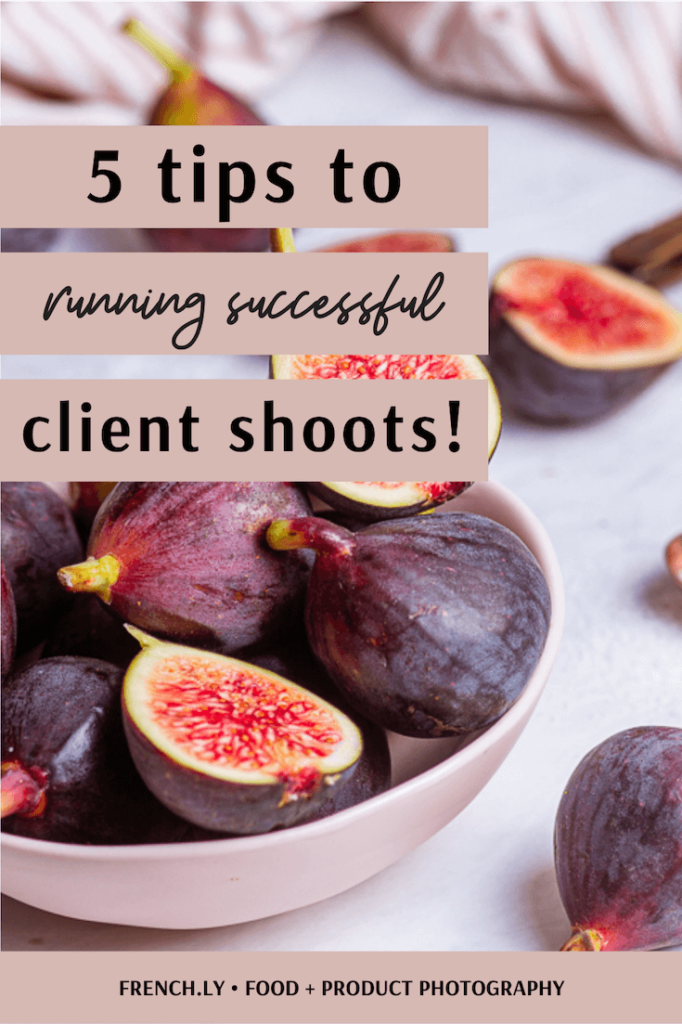In this guide, I show you how to choose who to pitch, how to find the right contact information, and how to craft a winning pitch.
PITCHING TO BRANDS AND IS THE BEST WAY TO GET YOUR IDEAL CLIENTS, AND YOU CAN DO IT WITHOUT FEELING ICKY
Gimme the Guide!
11 FOOD PHOTOGRAPHY DOCUMENTS EXPLAINED
Top Posts
11 PLACES TO SOURCE AFFORDABLE PHOTOGRAPHY PROPS AND BACKDROPS
30+ FOOD STYLING TIPS TO ELEVATE YOUR FOOD PHOTOGRAPHY
Free Resource
About Frenchly
I am a food + product photographer & educator specializing in eco-friendly and sustainable brands. When I am not working with clients, I empower creatives to start their journey by sharing my knowledge on the business of food + product photography.
5 Tips to Running Successful Client Shoots
September 11, 2019
We all have things we are afraid of. (Heights, public speaking, spiders…need I go on?) But one fear I think most of us share is a perfectly natural one: fear of failure. Fear of failure is the reason a lot of aspiring photographers never really get their business off the ground. We fear that we won’t be able to run a successful client shoot and deliver what the client wants. But what if you had the tools to move past that fear and accomplish something great? Wouldn’t that be worth it all in the end?
“The only thing we have to fear is fear itself.”
-Franklin D. Roosevelt
Despite how it may feel at the time, failure is not the end of the world. When I first took the leap into professional photography, I had a couple of projects that didn’t go the way I was hoping. And on top of the personal anxiety I felt at not achieving my goal, I had to gather my courage and break the news to my client.
Do you know what happened?
Nothing.
My career as a photographer didn’t end there. I handled the situation. The client and I broke up like adults. He didn’t destroy my reputation, didn’t tell all his friends what an awful photographer I was. Do you know what did happen though? I learned a ton, and I carried that knowledge over into my next project and the next one after that, and I reached the point where I can consistently run successful client shoots because of the things I learned from my early failures. Here’s how you can join me.
1. Set the Expectations
When I work with food brands for product-style images, I like to offer packages. The packages are well-defined and the client knows exactly how many images he’ll get. There are no surprises. I talk over all of the important details before I take the first test shot. I put together a mood board and work closely with my client to agree on a shot list.
In some cases, packages are not an option and you need to tailor your project to the client’s needs. Specificity is a life-saver for the photographer-client relationship. We’ve all had that client who expected you to work miracles. Make sure to manage those expectations up front, so when you turn over those final images your clients know exactly what they’re going to see, how much of it they’re getting, and what they can do with their images going forward. If you need step-by-step guidance on how to onboard new clients, check out this blog post.
2. Be Honest
If you are new, just let the client know. Don’t try to hide it. They saw your work and they like it! When you try to pass yourself off at a much higher level than you are actually capable of working at, you are setting yourself up for failure and almost guaranteeing a disappointed client. If you are open with your client about what you can realistically do for them, those clients will return to you for exactly that honesty, and your working relationship might grow over time as your skills become more advanced!
3. Know Your Skills
Take on projects you are qualified for. Note that I am not saying you should never try anything new! There’s a difference between challenging yourself and getting in way over your head. I try new techniques in my food photography all the time, and every time I master a new skill I feel my confidence shoot through the roof!
But do you know what I don’t do? I don’t go out and offer to shoot a wedding, which is a completely different skill set that I haven’t even dipped my pinky toe into. Make sure you have the skills necessary to take on a project before agreeing to do it. Challenge yourself by degrees…it’s only fair to your client, who is paying you after all!
4. Make Time to Practice
Practice builds confidence — and your portfolio! Make sure you actually practice the skills you want to offer your clients, even if you already feel pretty solid about them. In fact, it’s sometimes helpful to create an imaginary client and practice on them. Remind yourself about how you will make contact, what materials you will share with them, and how to go about getting the job set up. Put together a shot list and a mood board, then conduct the actual shoot. When the real client rolls around, you’ll have a handle on your process and a healthy portfolio to show off.

I make sure to practice new skills or new lighting techniques on a regular basis before using them for client work
5. Agree on a Deadline
It is so, so important to know your time frame, especially with a new client. Vague terms like “not urgent” or “sometime soon” might mean something completely different to you than it means to your client, so work together to find a measurable deadline.
Be real with yourself during this process. If you are just getting started with professional photography (or if you are working this as a side hustle) you might need extra time to complete the project. Make sure to leave yourself a little breathing room in your estimation, so you have some buffer if you run into an obstacle. Even if everything goes according to plan and you don’t need the extra time after all, you’ll be able to deliver the work early and exceed your client’s expectations. Win-win!
Bonus Tip: When You Fall Short, Own Up to It
Remember what I said earlier about honesty? If you are having issues completing the job, communicate that to your client. Let them know you are running into a problem. You are most likely able to complete the job if you are given the time but more often than not, clients are on a strict timeline. If you realize that you will not be able to complete the project in the said timeline, do not wait any longer. You will only waste more of the client’s time and aggravate the situation. Be open and let them know.
And sometimes you have done everything right and the client is still not satisfied. Even if you are absolutely right and the client is being unreasonable, you really only have two options. You can stay firm and refer the client back to their contract/mood board/shot list, but you will most likely never work with that client again. (If he is being a difficult client, that might be for the best.) Alternatively, you can put aside your pride and try to salvage the situation by offering a refund or additional images. I’ve found that giving a few free images is often enough to make a happy client, though you’ll need to assess for yourself whether that’s a precedent you’re willing to risk setting.
If you’re looking for the number one way to set yourself up for a successful client shoot, open and honest communication is the best place to start. Even when it’s uncomfortable, communicating your progress to your client will instill confidence in your integrity, and that’s a really big deal, especially when you’re working remotely. That’s why I started and ended this blog with honesty!
Do you have anything to add? I would love to know what steps you take to set up a successful client shoot. Add your tips in the comments below or let’s keep the conversation going on Instagram!

Leave a Reply Cancel reply
| Created with Showit
| Design by Oregon Lane Studio
| Privacy Policy
© 2020 Frenchly Photography
Back to Top
THE WEBSITE
THE BLOG
Helping brands and businesses promote a happy, healthy and sustainable lifestyle through stunning food and product photography